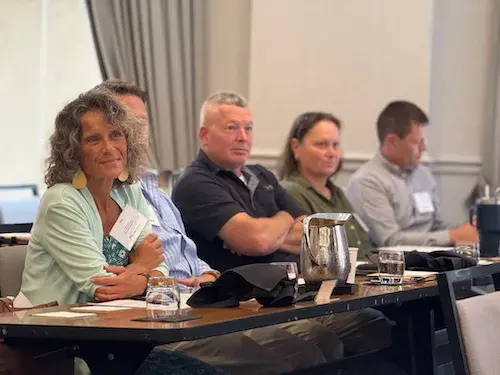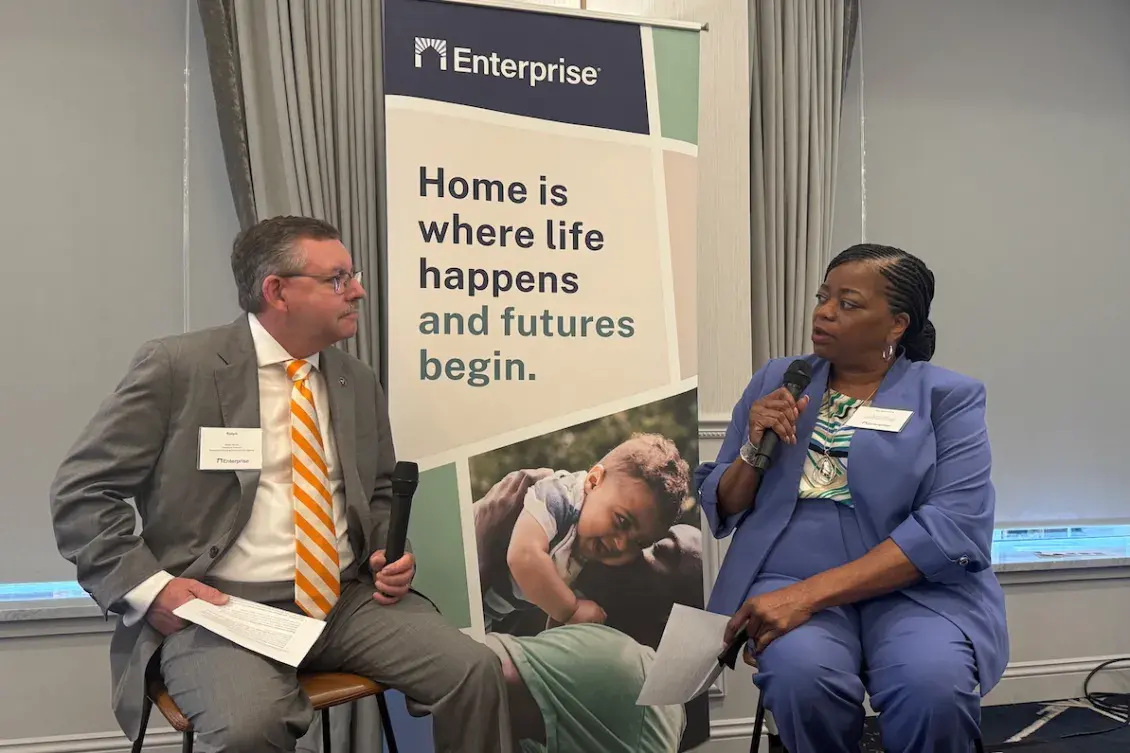For many families, seniors, and workers who live in rural areas across the country, affordable housing makes it possible for them to remain in the communities they call home. Yet these rural communities face distinct challenges in preserving and creating safe, affordable housing, including limited financing options, aging rental stock, construction workforce shortages, and escalating insurance costs.
Against this backdrop, more than 100 housing providers, policymakers, public housing officials, and financial experts gathered in Knoxville, Tennessee, in August to exchange insights and strategies for protecting affordable homes in rural communities. The convening builds on Enterprise’s ongoing commitment to sustaining rural rental housing across the country.
A highlight of the event was a fireside chat featuring Ralph Perrey, executive director of the Tennessee Housing Development Agency, in conversation with Dr. Christie Cade, Enterprise VP and Southeast market leader. Together, they explored innovative solutions Tennessee is using to address rural housing challenges across the state.
Dr. Christie Cade: One of the things that has happened in Tennessee is that you’ve brought innovative ways of financing forward. Can you explain how the Community Investment Tax Credit (CITC) works and its impact on both the production and preservation of housing?
Ralph Perrey: This [the CITC] was something Tennessee legislation created about 20 years ago. We don’t have a state income tax, but we do give banks a break on their franchise and excise tax—our principal business tax—if they provide below-market-rate financing for things like affordable housing development and preservation.
It brings about $40 million worth of tax breaks to banks each year, which means they’re investing much more than that into affordable housing across the state. Our role is to make sure the purpose and recipient are eligible, then the Department of Revenue does the heavy lifting. It’s been very helpful to development partners, saving them thousands in costs.
Have you seen this used for preservation and single-family housing as well? Not so much with single-family. It’s been used more for housing development on a larger scale. For example, in tax credit developments, if you still need to borrow money, the CITC helps you get a better rate. That’s why the legislature saw a spike in claims—developers realized they could use it effectively.
When you think about the 20 rural counties in Tennessee, what comes up in conversations beyond “we need more money”?
We can only build what communities allow us to build. That leads to discussions about zoning, regulation, and permitting. If you require three-quarter-acre lots, you can’t build anything affordable.
Some communities want more housing for newcomers. Others want to slow growth. But not building doesn’t stop people from moving; it just prices out locals. Starter homes are especially scarce. They once made up 40% of new builds, now it’s only 7%.
We’re working on a revolving loan fund to encourage developers to build small homes—say, 1,500 square feet—by offering interest-free construction financing. Oklahoma tried this with $53 million and got 260 homes built. We think we could create 200–300 homes a year.
Who else do you see as key partners in preserving affordable housing?
Besides Enterprise, of course, FAHE and its affiliates are indispensable in East Tennessee. Rural LISC has opportunity centers in the region. NeighborWorks affiliates are very strong partners, too.
We also need investors willing to buy tax credits for smaller Appalachian projects. As new economic development emerges—such as the Ford Blue Oval plant in West Tennessee—we must link housing efforts to infrastructure. Without water and sewer, you can’t build housing.
Is the private sector, outside of banks, stepping up in rural housing preservation?
Some community banks are active locally, but overall, nothing affordable gets built without subsidy. Local governments can help by making land available, extending water and sewer, or adjusting zoning to allow multi-family or modular homes.
What other innovative approaches are you trying?
We launched a Development Gap Subsidy Program. If it costs $210,000 to build a home but it only appraises at $150,000, we cover the $60,000 gap so the home can be sold instead of rented.
It’s a simpler, lower-budget version of the Neighborhood Homes Investment Act. We just made our first commitments to five or six partners around the state. We’ll see how it works, but we hope it spurs rural development.

Looking ahead, what’s top of mind for FY25 and FY26?
We’re pushing for money to start that revolving loan fund for starter homes. Governor Bill Lee deserves credit—he’s the only Tennessee governor ever to propose a direct appropriation for THDA.
I’m also interested in Virginia’s model, where housing funds follow new job creation in small communities. If Tennessee can tie housing to economic development efforts, that could be powerful.
Tennessee has faced disasters. How is THDA approaching disaster recovery and repair?
We’d love to do more, but federal disaster money hasn’t flowed through us. The one thing we did was repurpose $8 million in HOME dollars for eight counties hit hardest by Hurricane Helene’s flooding. It wasn’t much, but it was what we had.
The bigger conversation is about FEMA and how funds move through different entities. That’s beyond us.
What advice do you have for organizations about working with their housing finance agencies (HFAs)?
Figure out who handles what in your state—sometimes housing is split between multiple agencies. Engage them. HFAs should be asking what communities want, not telling them what to do.
We also need to simplify requirements. Some federal rules, like Davis-Bacon reporting or environmental reviews for very small projects, add months of delay. Programs like HOME could be improved significantly.
Any final thoughts?
Everything we do is through partners, and none of them have to work with us. So we owe it to them to be responsive and effective.

